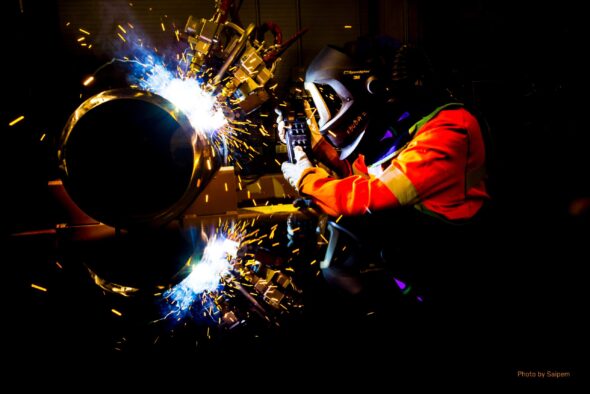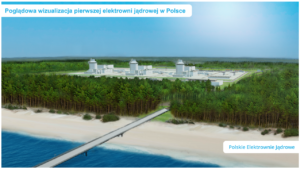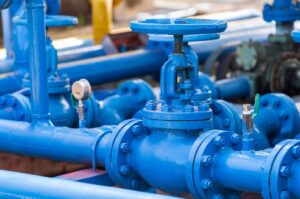Gas prices are approaching the peak last seen right after Russia attacked Ukraine. The fate of deliveries via Nord Stream 1 is uncertain, despite concessions to the disputed turbine. Gazprom is pursuing the Kremlin’s political goal of paralyzing the West with uncertainty. It can turn off the gas tap at any time anyway. Paradoxically, this is an opportunity for Poland and other member states – writes Wojciech Jakóbik, editor-in-chief at BiznesAlert.pl.
A new ultimatum
On July 11, the planned technical break for the Nord Stream 1 gas pipeline will start, it will last until July 21. Gazprom will receive the turbine serviced in Canada, because Ottawa, at the request of the Germans, will suspend part of the sanctions for Russia’s attack on Ukraine to hand over this device in the face of the threat of gas shortages on the German market, caused by a possible shut down of the pipe that goes under the Baltic Sea. However, the Russian Kommersant daily is already speculating that the Nord Stream 1 may be out of use longer, because handing over the turbine to Gazprom will take time. It should be noted that Gazprom did not need it to increase gas supplies to Europe. First, it could have used other turbines that are at its disposal. Second, it could have increased the gas transit via alternative routes, especially those going through Ukraine. The company is not doing this and instead continues to restrict the gas flow. This means Nord Stream 1 is most probably a prepping ground for another stage of the energy crisis that is fuelled by Russia.
The history of gas supplies from Russia analysed on the basis of ICIS data shows that in the previous decade, Nord Stream 1 interruptions were compensated by exports via alternative routes: the Yamal pipeline through Belarus and Poland, the Soyuz pipeline through Ukraine and Slovakia, and the Turkish Stream through Bulgaria, available from 2020. The year when the pandemic started – 2020, was already different, because the Russians reduced supplies through Ukraine to 60 billion cubic meters a year, which were imposed on Moscow as part of the interim agreement from 2019, which saved Europe from Russia drying the pipe at that time. The volume of Russian gas that reaches the Old Continent is usually at 500 mcm per day, and it was reduced in 2020 by 120 mcm a day. During the technical break for Nord Stream 1 in 2020, 25 percent of the missing capacity was replaced with alternate routes (120 mcm daily) instead of the usual 35-45 percent. In 2021 the gas deliveries to Europe started to drop around the time of another maintenance break scheduled for Nord Stream 1, which was compensated at 20 percent. Since then, the Russians have systematically reduced the supply of gas to Europe, and the technical break in 2021 has not been compensated for yet via other routes. There has also been a change in the situation, because the Yamal pipeline is not available due to Russian counter-sanctions excluding it from deliveries to Europe. It is not clear how long the pause will last this year. The Russians can use it either tactically to further lift gas prices, or strategically to further reduce gas supply ahead of the 2022/23 heating season. The logic of de-escalation by escalation, through which the Russians want to use gas to paralyze Western support for Ukraine, makes one fear that there will be a further reduction in supplies from Russia, with the possibility that they will be halted altogether. New pretexts, apart from the ruble ultimatum from May and the dispute over the turbine from Canada from June, may pile up, including problems with using the said turbine, as already suggested by the Kommersant. This is probably why Germany has already introduced gas rationing, and France is preparing alternative sources of energy supply in case of shortages.
Meanwhile, EU’s gas storage is full at 60 percent with differing storage levels across the member states. Poland filled its storage facilities at 97 percent, and Croatia at 37 percent. Germany, the key EU economy, currently has around 60 percent of its storage capacity full. The EU target as part of the REPowerEU plan is 90 percent at the EU level. The Russians probably continue to lower the supply in order not to deliver the gas at all. Then the reserves will not be enough, and the only option will be to reduce gas consumption, first in industry, and then in households. The SOS security of supply regulation, adopted with the participation of Poland, regulates the joint use of stocks and allows us to imagine a scenario in which Polish stocks also serve Germany, provided that such a decision would not put at risk vulnerable customers, such as schools or hospitals in Poland. Such a solution is controversial in the eyes of the Polish public, due to the fact that Germany found itself in such a difficult situation at its own doing, becoming reliant on „cheap gas from Russia”, which ultimately turned out to be expensive economically and politically, because its shortages threaten a recession, and Germany returning to coal during the crisis undermines the credibility of the entire EU energy and climate policy.
Cooperation beyond divisions
However, it is necessary to share gas supplies with needy neighbours like Germany in accordance with the SOS regulation for several reasons. Firstly, this is what the regulations that are part of the protective umbrella created by the member states as a shield against Gazprom, say. Just like the possibility to make joint gas purchases, these tools will be used to get through the crisis and become independent of Russian gas by 2025-27. Secondly, the provisions that may be used by the Germans in the heating season 2022/23 may also be used by Poland in the coming years. Berlin is to have its first floating LNG terminal (FSRU) in February 2023 and abandon deliveries from Russia by 2024. This means that in the coming years alternative routes of gas supply from Germany can support Poland’s security, and the route through the reverse flow on the Yamal gas pipeline will again become an important source of supplies to Poland after the interruption caused by the drying Nord Stream 1. It is worth recalling that the Poles used this route as much as possible to import, mostly Russian, gas from the German exchange and replenish their reserves before the winter. The technical intermission on Nord Stream 1 may limit this possibility, and if the pause is extended, the Yamal reverse flow will dry up.
Polish expectations towards Germany
However, the above situation makes it possible for Poland to articulate certain expectations towards the Germans. The EC stance on coal after the Russian attack on Ukraine suggests that the Commission may be willing to turn a blind eye here and there when it comes to the climate policy. Its proposal to include gas and the atom in the taxonomy, a catalogue of investments deserving the support of banks, adopted by the European Parliament, reveals that the largest member states – France, Germany and Poland have reached a compromise on diversifying the sources of supply of gas thanks to new projects, securing the energy transition and reducing the consumption of fossil fuels thanks to nuclear energy. The Poles may expect Europe’s energy security to be made more robust thanks to other initiatives as well. That is why they are demanding a maximum price for CO2 emission allowances, as stated in an article by the Polish Prime Minister in the Financial Times. They may formulate more expectations, such as scrapping the plans for shutting down the three remaining nuclear power plants in Germany, which will increase the energy supply and reduce the demand for gas and coal in this country, and thus relieve the entire market. They may expect to receive access to German ports for coal shipments from outside Russia to Poland. Poles can also expect that, according to the suggestion of the German Minister of Climate and Economy, Nord Stream 2 will be demolished and its infrastructure in Germany will be used for LNG supplies. They may formulate other demands arising from the need to respond to the energy crisis fuelled by Gazprom. The interdependence of Poland, Germany and other member states means that this is not the last time when we will need each other’s energy, coal, or gas – sometimes Berlin will help Warsaw, other times the other way around. This is an opportunity to turn this situation into a permanent policy coordination with political bargaining in the background. An important aspect is the mediation of the EU institutions, which will legitimise energy and climate policy at community level. The intermission of Nord Stream 1 in 2021 dictates the rhythm of the energy crisis fuelled by Gazprom, and the spectre of further escalation must be reckoned with. However, the EU countries, led by Poland and Germany, will emerge from the crisis stronger and independent of Russian gas thanks to effective cooperation giving rise to an active EU policy. For now, it’s time to ration the gas. Analysts from the Bruegel center suggest that the demand in Poland should fall by a quarter for the country to get through the complete halt of gas supply from Russia to Europe unscathed.









